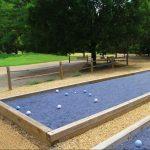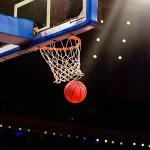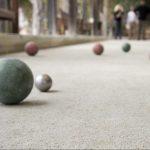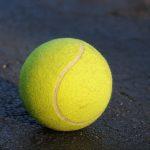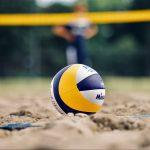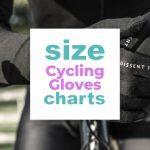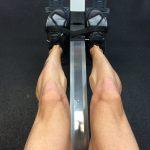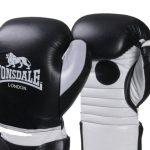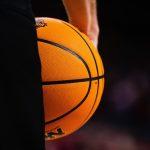Baseball Size and Dimensions
Baseballs are spherical balls used to play the sport of baseball. They are small enough to comfortably fit in one hand. Baseballs are easily identified for their iconic red stitching. The spherical ball contains a rubber or cork center encased in yarn. The core of a baseball is coated by two white leather pieces, shaped like peanuts, stitched together by a red thread. The stitching is an essential element as it impacts the ball’s drag (skip straight to the baseball size charts).
In the early 19th century, baseballs were manufactured in a variety of sizes, shapes, and weights. The balls were made of a rubber core encased in yarn and leather. In some places, cores consisted of fish eyes. Pitchers typically produced their balls, which were used all through the game. As time went by, baseballs evolved.

Today, there are three types of baseball used, hard baseball, rubber baseball, and soft baseball. A hard baseball is an ordinary baseball used in major-league baseball while a rubber baseball is used to play rubber baseball before high school in Japan. Soft baseball on the other hand is used for practice baseball or softball baseball, which can be played indoors.
A regulation baseball has a circumference of 9 to 9.25 inches ( 22.9 to 23.5 cm), which translates to 2.86 to 2.94 inches (7.3 to 7.5 cm) in diameter, and weighs 5 to 5.25 oz (142 to 149 g).
The most famous baseball brands are Wilson, Rawlings, and Diamond.
Baseball size is a crucial factor in the baseball game. The size of your baseball affects your projectability, especially if you are a professional baseball player. Therefore, to play exceptional baseball, you will have to use a right-sized ball. Read through this guide to learn more.
Jump right into the Frequently Asked Questions
Related: Baseball Glove Size Charts & Guide, Baseball Bat Size Chart
Baseball Size Table of Contents
Baseball size chart
Related: Soccerball Size Guide and Dimensions
Baseball is one of the most popular ball sports in the United States. Millions of players play it. However, what are the actual measurements of baseball and how much does it weigh? Well, let’s find out.
The handy charts below cover everything about baseball size from diameters, and circumferences, to weight.
Note: inch, cm, mm, oz, g, and lb measurements are approximate roundings.
Regular baseball size chart
| Measurement | Max | Min |
| Circumference | 9 inches 22.9 cm 229 mm | 9.25 inches 23.5 cm 235 mm |
| Diameter | 2.86 inches 7.3 cm 73 mm | 2.94 inches 7.5 cm 75 mm |
| Weight | 5 oz 142 g 0.31 lb | 5.25 oz 149 g 0.33 lb |
Baseball/Softball ball size chart
| Item | Circumference | Diameter | Age |
| Baseball | 9 inches 22.9 cm 229 mm | 2.9 inches 7.4 cm 74 mm | All ages |
| T-Ball | 10 inches 25.4 cm 254 mm | 3.2 inches 8.1 cm 81 mm | Up to 9 years old |
| Softball 1 | 11 inches 27.9 cm 279 mm | 3.5 inches 8.9 cm 89 mm | 10 to 14 years old |
| Softball 2 | 12 inches 30.5 cm 305 mm | 3.8 inches 9.7 cm 97 mm | Under 16s Open – 16+ years old |
How to choose the right baseball size
Related: Volleyball Size Chart
Before you start to play baseball, you need to understand the different sizes available, and which size suits you. There is an ideal baseball made for everyone interested in playing the game.
The right baseball size depends on factors such as the player’s age, and level of play.
Choosing a baseball of the ideal size for you can be overwhelming and devastating. However, we intend to eliminate all your worries by explaining everything you need to know about baseball sizes.
Baseball sizes by age
Baseball sizes vary to meet the needs of players of different ages. Generally speaking, younger players cannot play with a baseball of the same size as an adult ball. At a young age, baseball should be played for fun.
If you buy your child a hard baseball, it may cause them unnecessary pain like stinging palms while batting a wrong-sized baseball. This may force the kid to despise the game.
In most cases, once a kid loses interest in baseball, it’s almost impossible to have them play again. For this reason, you should always consider buying baseballs that are age appropriate.
Let us look at the six categories of basketballs.
1. Safety Baseballs
Safety baseballs are specifically manufactured for very young baseball players aged 3 to five years, interested in playing in starter leagues.
Safety baseballs are lightweight and have more soft surfaces than other baseballs.
These balls are affordable since they are made from man-made materials. In addition, safety baseballs are suitable for lighter aluminum baseball bats.
2. Reduced Injury Factor Baseballs (RIF)
Reduced Injury Factor baseballs are designed to perform better than safety baseballs. They are made of a poly combination to make them softer compared to regular baseballs for youths. This feature minimizes the risks of injury.
The term Reduced Injury Factor also correlates with SEV Index Levels.
The SEV INDEX measures the impact force applied on the body by a baseball. There are three different SEV INDEX Levels.
- SEV INDEX Level 1 Baseball
Out of the three levels, these baseballs are the softest. They are suitable for kids aged 5 to 7 years. Unlike safety baseballs, SEV Index Level 1 baseball is stiffer. Nevertheless, these balls still yield deflections in abundance to minimize the sting when struck.
SEV Index Level 1 baseball covers are made of genuine leather and raised seams providing better hold for small hands.
- SEV INDEX Level 5 Baseballs
Out of the three SEV Index Levels, these baseballs are considered “middle models”. They are ideal balls for players aged 8 to 12 years. However, these balls are used by 7-year-olds in most leagues.
SEV Index Level 5 baseballs are stiffer compared to SEV Index Level 1 baseball. This means that they sting hard when hit.
- SEV INDEX Level 10 Baseballs
Designed for baseball players who are 12 years and above. Just by looking at them, you can differentiate them from high school-level baseballs.
3. Youth Tournament Baseballs
Youth league baseballs are ideal for experienced players in the game. Young players aged 8 to 14 can use this ball. The size of these baseballs is 8.75 inches in circumference.
These balls are comparable to high-school and college baseballs except that the wool winding is looser. This makes the baseballs a bit softer.
4. High-School and College Baseballs
Baseballs in this category are lightweight compared to professional-grade baseballs. Suitable for players aged 14 and above. The size of these baseballs is 12 inches in circumference.
Their covers are often made of high-quality synthetic leather or genuine leather.
High school and college baseballs are ideal for metal or blended bats compared to wooden bats.
5. Professional-Grade Baseballs
Major league teams use only the baseballs with the highest quality while minor league teams use the lowest-quality professional-grade baseballs. These baseballs are used by pro players.
Their covers are made of high-quality leather with regular seams.6. Practice Baseball
As its name, practice baseballs are used for practice and recreational play. They are cheap, inefficient, and can distort easily
Baseball Weight
The weight of different baseballs can never be the same. This is because of some specific differences in raw materials as well as other external factors.
The weight of modern baseballs partially depends on the material, which is a combination of rubber and cork and a black rubber external layer. In addition, there is a case of red rubber essentially wrapped in yarn.
The official baseball weight varies from 142 grams to 149 grams which translates to 5 to 5.25 ounces.
Different baseball leagues use baseballs of different weights. To conserve fairness and cohesion in the game, every ball used in MLB has its weight monitored strictly throughout the manufacturing process. The Major League Baseball weight ranges from 5 to 5.25 ounces which equates to 142 to 149 grams.
However, the Minor League baseball weight is between 4 to 5 ounces or 113 to 142 grams.
Ordinary baseball weights are the same as Major League baseballs. However, softball baseballs weigh about 90% less than ordinary baseballs. Huge difference, right?
How does the weight of a baseball affect young players in the game? Among youth baseball players, an increase in the weight of the ball correlates with decreased pitch velocity, increased medial elbow torque, and reduced arm speed.
Baseball Materials
Baseball materials influence the choice of the ball you choose. What would you find inside if you cut a baseball in half? The inside of a baseball is made of several layers, that we are going to look at.
- The core
The center of a baseball is known as the core. It consists of exclusive cork, rubber, or both for some balls. However, training baseballs go without this cork center. There are two types of cork cores; cork and rubber, and cushioned cork.
Research done in the past shows that baseballs made of a cushioned core are more remarkable than those with cork and rubber pills regarding travel velocity.
Additionally, baseballs with cushioned cork centers have the ability to preserve their shape better than baseballs with rubber and core.
All professional class MiLB and MLB together with multiple college baseballs prefer cushioned cork centers baseballs.
- Windings
Baseball windings are the chunky layers of wool yarn encompassing the core. Wool was chosen as the baseball’s winding central material due to its flexibility/buoyancy which allows it to compress when pressure is exerted, then quickly go back to its original shape.
This property enables the baseball to preserve its perfectly spherical shape despite being hit continually during play.
Cotton/poly is used for the outer wrapping to give extra strength and minimize the possibility of tearing after the cowhide casing is applied.
- Baseball cover
When buying baseballs, you’ll find baseball covers made of two different outer materials, genuine leather, and synthetic leather.
A genuine leather cover is durable and is a traditional option for most youth baseball teams because it has the best grasp. Look for the stamp on the ball labeled “Genuine Leather”.
However, genuine leather covers have changing thickness and quality. The more expensive it is, the more the quality.
Most baseball covers are made of genuine leather. Baseballs with synthetic leather covers are normally downgraded to practice.
- Stitching
Surprisingly, most baseballs are stitched by hand. All baseballs consist of 108 stitches to bind together the baseball cover. The majority of stitching threads are classic red, even though different colors can be used.
Baseball stitching is available in three types, raised, rolled, or flat.
The raised stitches are ideal for beginners. The baseball with these stitches tends to grip the air excellently and ease control.
Rolled seams are used by the MLB. This is because they have reduced friction which allows high-speed throwing.
The flat seams are poor choices for any flashy pitches. However, they are a perfect choice for batting practices. Additionally, they can only be used on genuine leather covers.
Related: Ping-Pong Ball Size Chart
Learn more about Baseball Size and more (video)
Frequently asked questions
Are there different sizes of baseballs?
There are six different sizes of baseballs. These are; Safety Balls, Reduced Injury Factor Baseballs (SEV INDEX Levels), Youth Tournament Baseballs, High-School and College Baseballs, Professional-Grade Baseballs, and Practice Baseballs
What is the size of a baseball in cm?
A regulation baseball has a circumference of 22.9 to 23.5 cm, which translates to 7.3 to 7.5 cm in diameter.
How much does a baseball weigh?
A regulation baseball weighs 5 to 5.25 oz (142 to 149 g).
Is a baseball bigger than a cricket ball?
A regulation baseball has a circumference of 9 to 9.25 inches ( 22.9 to 23.5 cm), which translates to 2.86 to 2.94 inches (7.3 to 7.5 cm) in diameter, and weighs 5 to 5.25 oz (142 to 149 g), while a cricket ball must have a weight ranging between 5.5 to 5.75 ounces (155.9 to 163.0 g) and measure 8.8 to 9 inches (22.4 to 22.9 cm) in circumference. Therefore, a baseball is slightly bigger than a cricket ball.
What baseball is used in high school?
High-School and College Baseballs are used in high school. They are lightweight compared to professional-grade baseballs. Suitable for players aged 14 and above
What baseball size is best for competition?
Baseballs best for competitive play are between 9 and 9.25 inches in circumference.
Is softball harder than baseball?
Scientifically, softball is harder than baseball.
Conclusion
It’s no lie that choosing the right size of baseball can be overwhelming. There are many sizes of baseballs available in the market today. However, worry not for we’ve got you covered! This baseball size guide has equipped you with everything you need to know about baseball sizes. Whether you are looking for a suitable baseball size for your child or yourself.
We hope that this guide has answered any questions you had concerning baseball sizes.
Thank you for reading this article. Feel free to leave any comment or question in the comment box below.
Picture in this post is by Jose Francisco Morales on Unsplash
Related to Baseball Size
- O’Neill Wetsuit Size Charts
- Bocce Ball Court Size and Dimensions
- Pickleball Court Vs. Tennis Court
- Basketball Hoop Rim Size and Diameter
- Ping-Pong Ball Size Chart
- Baseball Size and Dimensions
- Soccerball Size Guide and Dimensions
- Bocce Ball Size Chart
- Basketball Size Guide
- Tennis Ball Size Guide and Dimensions
- Volleyball Size Chart
- Cycling gloves size charts
- Steps Calculator: Steps in a km + Distances
- Jet Ski Size: Which Size Should You Go For?
- Rowing Machine Sizes and Types
- Sailboat Size Guide for Beginners and PROs
- Martial Arts Ring Sizes
- Hummel Size Charts
- Millet Clothing Size Charts
- Lonsdale Boxing Sizes
- Sports Ball by Size
- Mammut Bags and Backpacks Sizes
- Nordica Ski Sizes for Adults and Kids


